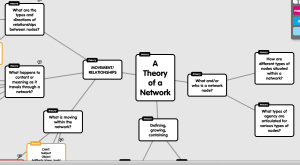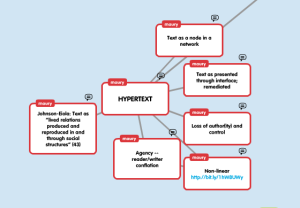I enjoy visualizing things. I really do. One thing I definitely do more of after taking this course is visualizing in new ways. When I visualized in the past, it tended to be with paper and pencil, and an attempt to draw things in that visceral way. In the heat of an excited epiphany, I still tend to reach for paper/pencil, either to jot or to draw. Old habits die hard, and, well, these tools are ubiquitous, cheap, and don’t require batteries or cords.
But I find my life and learning transitioning ever more to the digital realm. I also am doing more natively digital, vs. using a paper-based process and then transliterating it to the digital. Google Drive is now a regular part of my thought process, and I see benefits to parking my thinking in Popplets as well. Being forced to continue in a visual media, and to revamp and revisualize thinking over time using Popplet has forced me to think about how ALL the things might fit together, rather than as a series of blog posts or reading notes. Being forced to reconceptualize it in a non-linear way, too, is a good exercise for extending critical thinking and making connections. I had already done that a few weeks before we were assigned to do so, as that method began to make more sense to me in terms of finding places of consonance and dissonance. Thus, my last few MindMap posts and updates have been on this new format, organized around the questions we were using with our Case Studies, modified slightly to create some über-nodes, Castells-style.
It is also nice to have a record of my developing thought processes over the course of the semester. I see how at first I was using the tool as a kind of note-taking place, adding quotes surrounded by the particular authors. This makes sense as a start since I didn’t have a lot to connect the ideas to. This approach quickly became unwieldy, both due to the size of Popplet boxes and it kept me within each text, even though I could draw lines between authors. What frustrated me a bit was that I couldn’t demonstrate the TYPE of connection with the lines. I enjoyed the Theory Tree better because we could have some basis of describing influence: citations, publication dates. That made me think that a network and a visualization have this in common: both need a basis and protocols to define the parameters for what is being connected, why, and how. There must be an “according to” that regulates what gets included and how it is placed. Otherwise, it can resemble stream-of-consciousness or a scatter-plot that doesn’t converge. I felt my original mind-map was becoming that way: mere boxes and lines without a structure. Although I recognize this now as a more organic or rhizomatic growth structure, it was not conducive for constructing meaning (beyond the meaning that connections could be made anywhere).
I am struck by the notions that several of our authors made (help me out here: Foucault, Biesecker, Latour, D&G, I believe), that one MUST construct meaning, one must impose subjectivity, one must recognize the imperfectness of any map or graph or use of language to describe or capture or “see” or “mean”, but one must use these tools nonetheless. Otherwise, we have no individual agency or means to construct, resist, narrate, make sense, or in a Cartesian sense, to exist. Earlier in the semester I was playing with Cogito Ergo Sum and variants earlier in the semester. Loquor ergo sum (I speak, therefore I am) might be useful for rhetorical theory, the idea that the act of discourse is not only epistemological and ontological, but also existential. Scribo ergo sum (I write, therefore I am) is useful in terms of rhet/comp and genres. The creation of text, of artifacts, of boundary objects and actants, creates and constructs reality. Bazerman, Miller, Hall, Popham, Johnson-Eilola, Joyce, Spinuzzi, and possibly (I have not decided yet) Rickert would agree. But the one I was really thinking about for the 21st century information society is Intersum ergo sum, I am involved/participate, therefore I am. It seems to me that nothing is made, understood, or exists except in relation to another (which has been a theme in our reading all semester). I am my own network. We are the network. The network is us. Reticulum est nobis. A mesh. A weave. We are the weavers and the wearers. We are we.


